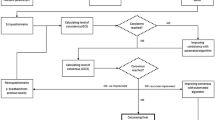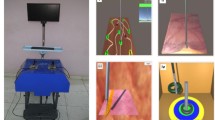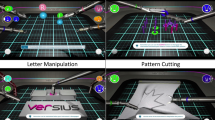Abstract
Background
It has been suggested that virtual reality (VR) might be useful for the selection of surgical trainees and the measurement of technical performance during preoperative training and retraining. This study was designed to determine whether it is possible to define and measure the acquisition, loss, and reacquisition of psychomotor skills in novice surgical trainees.
Methods
Novice surgical trainees (NSTs n = 10, junior surgical registrars with little or no prior experience with laparoscopic surgery) were tested and retested after 1 month using the Minimally Invasive Surgical Trainer–Virtual Reality. Two tasks were used: the simple task [stretch diathermy (SD)] and the more complex task [manipulation diathermy (MD)]. The score was derived from the time taken to complete the task and the number of errors that occurred. Acquisition is the difference between the first and last score of the first training session, loss is the difference in score that occurs between the last score of the first training session and the first score of the second training session, and reacquisition is the difference in the first and last scores of the second training session. A performance criterion level was defined for each task by testing a group of experienced laparoscopic surgeons (n = 10). Groups were compared using the nonparametric Wilcoxon signed rank test, with p < 0.05 considered to be significant.
Results
Acquisition of skill was found for five of 10 NSTs with the SD task and 10/10 for the MD task. As a group the NSTs achieved the criterion level from the outset with the SD task and exceeded it by the eighth attempt for the MD task. The best score was achieved with fewer attempts during the second training session for the SD but not the MD task. The defined parameters are expressed as mean percentage score ± SD for the 10 NSTs and for each task. There was a 36% (±26) acquisition for the SD task compared with 50% ( ± 4) for the MD task (Wilcoxon p = 0.241). There was a 23% (±19) loss for the SD task compared with 81% (±16) for the MD task (p < 0.005). There was a 20% (±10) reacquisition for the SD task compared with 54% (± 7) for the MD task (p < 0.005). The mean scores were greater for the more complex task (MD), which was more useful in discriminating between the individual trainees and the two training sessions.
Conclusions
It is possible to use VR to define the acquisition, loss, and reacquisition of psychomotor skills in individual NSTs and to compare them with a predefined performance criterion level. This study defines parameters that will be useful in repeated training sessions of NSTs in the preoperative phase of training and during retraining.



Similar content being viewed by others
References
AG Gallagher AB Lederman K McGlade RM Satava CD Smith (2004) ArticleTitleDiscriminative validity of the Minimally Invasive Surgical Trainer in Virtual Reality (MIST-VR) using criteria levels based on expert performance Surg Endosco 18 660–665 Occurrence Handle10.1007/s00464-003-8176-z
AG Gallagher N McClure J McGuigan J Crothers J Browning (1999) ArticleTitleVirtual reality training in laparoscopic surgery: a preliminary assessment of minimally invasive Surgical Trainer Virtual Realtity (MIST-VR) Endoscopy 31 310–313 Occurrence Handle10.1055/s-1999-15 Occurrence Handle10376458
AG Gallagher K Richie N McClure J McGuigan (2001) ArticleTitleObjective psychomotor skills assessment of experienced, junior, and novice laparoscopists with virtual reality World J Surg 25 1478–1483 Occurrence Handle10.1007/s00268-001-0133-1 Occurrence Handle11760752
AG Gallagher RM Satava (2002) ArticleTitleVirtual reality as a metric for the assessment of laparoscopic psychomotor skills: learning curves and reliability measures Surg Endosc 16 1746–1752 Occurrence Handle10.1007/s00464-001-8215-6 Occurrence Handle12140641
TP Grantcharov VB Kristiansen J Bendix L Bardram J Rosenberg P Funch-Jensen (2004) ArticleTitleRandomized clinical trial of virtual reality simulation for laparoscopic skills training Br J Surg 91 146–150 Occurrence Handle10.1002/bjs.4407 Occurrence Handle14760660
JA Jordan AG Gallagher J McGuigan K McGlade N McClure (2000) ArticleTitleA comparison between randomly alternating imaging, normal laparoscopic imaging, and virtual reality training in laparoscopic psychomotor skills acquisition Am J Surg 180 208–211 Occurrence Handle10.1016/S0002-9610(00)00469-4 Occurrence Handle11084131
JA Jordan AG Gallagher J McGuigan N McClure (2001) ArticleTitleVirtual reality training leads to faster adaptation to the novel psychomotor restrictions encountered by laparoscopic surgeons Surg Endosc 15 1080–1084 Occurrence Handle10.1007/s004640000374 Occurrence Handle11727074
SS McNatt CD Smith (2001) ArticleTitleA computer-based laparoscopic skills assessment device differentiates experienced from novice laparoscopic surgeons Surg Endosc 15 1085–1089 Occurrence Handle10.1007/s004640080022 Occurrence Handle11727075
NE Seymour AG Gallagher SA Roman MK O’Brien VK Bansal DK Anderson et al. (2002) ArticleTitleVirtual reality training improves operating room performance: results of a randomized double-blinded study Ann Surg 236 458–463 Occurrence Handle10.1097/00000658-200210000-00008 Occurrence Handle12368674
J Torkington SG Smith BI Rees A Darzi (2001) ArticleTitleSkill transfer from virtual reality to a real laparoscopic task Surg Endosc 15 1076–1079 Occurrence Handle10.1007/s004640000233 Occurrence Handle11727073
Acknowledgment
This project was supported by a grant from Johnson & Johnson Medical.
Author information
Authors and Affiliations
Corresponding author
Rights and permissions
About this article
Cite this article
Windsor, J.A., Zoha, F. The laparoscopic performance of novice surgical trainees. Surg Endosc 19, 1058–1063 (2005). https://doi.org/10.1007/s00464-004-2200-9
Received:
Accepted:
Published:
Issue Date:
DOI: https://doi.org/10.1007/s00464-004-2200-9




